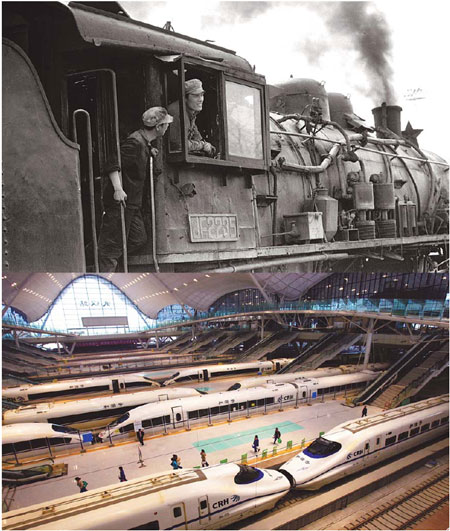On track for high speed
|
Top: Two drivers on a steam-powered locomotive at the Yongdingmen Railway Station in Beijing in 1981 . Above: Four lines of high-speed trains stop at Wuhan Railway Station in Central China's Hubei province on Dec 9, 2009. Top: Wang Wenlan / China Daily; Above: Ji Siliu / for China Daily |
Board any of China's high-speed trains and you'll step into a clean and comfortable cabin worthy of airlines. More important, the trains will whisk you to your destination almost as quickly as propeller-driven aircraft. These trains cover the 1,069-km journey between Guangzhou and Wuhan in about three hours, while the 120-km trip between Beijing and Tianjin is done in half an hour.
But it wasn't always so. Just two years ago, the Guangzhou-Wuhan train trip would take more than 10 hours, while you would have been hard-pressed to get to Tianjin from Beijing in less than two hours before 2008.
Indeed, it's been only three years since high-speed trains were introduced in China - and just four years after the State Council drew up medium- and long-term plans to develop a high-speed rail network for the country.
And by the middle of this year, another high-speed train link will open, joining Beijing and Shanghai and cutting the travel time of the 1,300-km journey from 10 hours now to about five hours or so.
Thirty years ago, train travel within China was completely different as the government was concentrating on pouring money into expressways rather than on the rail network. Yang Hao, who has been working at Beijing Jiaotong University teaching and researching on railway operations since the 1970s, recalls that trains then were overcrowded and slow.
"Most trains, called green trains, were pulled by steam locomotives and moved slowly," he says. In the 1980s, going from Beijing to Fujian province to visit his mother's family would take 42 hours.
During the holidays, the situation became worse. Cargo trains would be used to transport people on short-haul lines as there were not enough green trains. Hay was laid on the floor, with two long wooden boards on each side for passengers to sit on, Yang says. "Often the door could not be fastened. People needed air, and some needed to answer nature's call through that slot."
Yu Xuejin, another Beijinger, remembers that those trains, sometimes called "oxcarts", had very few seats, primarily reserved for the elderly and children.
In the 1980s, red trains with air conditioning started coming into service, although in many cases, it proved to be useless, especially in summer and with too many people crammed inside, Yu says.
China's rail network also began to face another problem: that of workers traveling to the cities to look for work, and returning to their hometowns during holidays following the opening-up and reform policy in 1981 that allowed farmers to work in cities to supplement their income.
These workers put the railways under great pressure, says Yu, who had worked in a locomotive factory but joined the staff of Beijing Railway Station in 1995.
In 1992, the government began expanding the rail network to meet the demands of China's booming economy. Track improvements and faster trains began to be introduced, giving opportunities to people such as train driver Li Dongxiao.
Before 1997, Li operated diesel locomotives which left his clothes with oil stains. These stains could not be removed by ordinary wash powder, and Li and his colleagues were given a special detergent to wash their uniforms.
The job also came with danger. Before the trains ran faster, most rail lines ran across roads and had no gates. Li says he had encountered flocks of sheep wandering on the railway and found children putting stones on the track many times.
He recalls a day in 1996 when out of Tianjin Railway Station, he saw a man walking on a parallel road. The man suddenly lay down on the track about 300 meters away in front of his train. Li hit the brakes, and the train stopped about 10 meters from the man.
But with faster trains, many crossings between railways and roads were eliminated and protection nets were installed along rail tracks. As well, the quieter and faster electric locomotives came into general use, and drivers such as Li switched over.
"Our working environment greatly improved," Li says. "On the 200-km/h trains, the cab we worked in is as clean as the passenger carriages. We also began to wear a white shirt and a tie. This was impossible when we were driving the diesel locomotives."
(China Daily 06/01/2011 page33)















